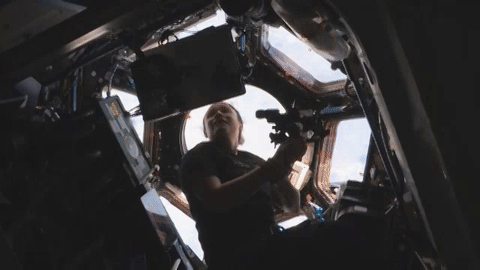ISS - Expedition 56 Mission patch.
Aug. 11, 2018
The crew members aboard the International Space Station spent this week conducting science, helping out with student robotic competitions, and preparing for next week’s Russian spacewalk when cosmonauts Oleg Artemyev and Sergey Prokopyev will work outside the station’s Russian segment for about six hours of science and maintenance tasks.
International Space Station (ISS). Image Credit: NASA
Read more details about scientific work last week aboard your orbiting laboratory:
SPHERES investigations soar through the station
Synchronized Position Hold, Engage, Reorient, Experimental Satellites (SPHERES), three free-flying, bowling-ball sized spherical satellites used inside the space station to test a set of well-defined instructions for spacecraft performing autonomous rendezvous and docking maneuvers, are used for a variety of investigations aboard the orbiting lab.
The SPHERES-Zero-Robotics investigation provides an opportunity for high school students to conduct research aboard the station. As part of a competition, students write algorithms for the satellites to accomplish tasks relevant to potential future missions. The most promising designs are selected to operate the SPHERES satellites aboard the station as a part of the competition.
Animation above: Two of the free-flying spherical robots used by the SPHERES investigations. SPHERES-Zero-Robotics gives students the chance to develop software to guide robots through a virtual obstacle course aboard the space station. Animation Credit: NASA.
This week, the crew members conducted dry runs in preparation for the final competition, which occurred Friday.
The SPHERES Tether Slosh investigation combines fluid dynamics equipment with robotic capabilities aboard the station. In space, the fuels used by spacecraft can slosh around in unpredictable ways making space maneuvers difficult. This investigation uses two SPHERES robots tethered to a fluid-filled container covered in sensors to test strategies for safely steering spacecraft such as dead satellites that might still have fuel in the tank.
This week, crew members set up the hardware and cameras before executing an experiment run.
Crew members use sextant to identify stars for use in future navigation
A tool that has helped guide sailors across oceans for centuries is now being tested aboard the station as a potential emergency navigation tool for guiding future spacecraft across the cosmos. The Sextant Navigation investigation tests use of a hand-held sextant aboard the space station.
Sextants have a small telescope-like optical sight to take precise angle measurements between pairs of stars from land or sea, enabling navigation without computer assistance. Sextants have been used by sailors for centuries, and NASA’s Gemini missions conducted the first sextant sightings from a spacecraft. Designers built a sextant into Apollo vehicles as a navigation backup in the event the crew lost communications from their spacecraft, and Jim Lovell demonstrated on Apollo 8 that sextant navigation could return a space vehicle home. Astronauts conducted additional sextant experiments on Skylab.
Animation above: NASA astronaut Serena Auñón-Chancellor conducting a star identification session as a part of the Sextant Navigation investigation. Animation Credit: NASA.
This week, the crew calibrated the sextant and performed the second star identification and sighting session of the investigation with European Space Agency (ESA) astronaut Alexander Gerst and NASA astronaut Serena Auñón-Chancellor. This session placed an emphasis on position stabilization and sighting.
For more information about the investigation, click here: https://www.nasa.gov/mission_pages/station/research/news/Sextant_ISS
Investigation studies how Earth’s magnetic field interacts with electrical conductor; sample exchanges begin
The European Space Agency’s (ESA) MagVector investigation studies how Earth’s magnetic field interacts with an electrical conductor. Using extremely sensitive magnetic sensors placed around and above a conductor, researchers gain insight into ways that the magnetic field influences how conductors work. This research not only helps improve future experiments aboard the station and other electrical experiments, but it could offer insights into how magnetic fields influence electrical conductors in general, the backbone of our technology on Earth.
This week, crew members performed the last set of planned sample exchanges.
Replacements completed in preparation for CLD Flames
The Advanced Combustion Microgravity Experiment (ACME) investigation is a set of five independent studies of gaseous flames to be conducted in the Combustion Integration Rack (CIR), one of which being Coflow Laminar Diffusion Flame (CLD Flame). ACME’s goals are to improve fuel efficiency and reduce pollutant production in practical combustion on Earth and to improve spacecraft fire prevention through innovative research focused on materials flammability.
Image above: ESA astronaut Alexander Gerst working within the CIR on the ACME CLD Flame investigation. Image Credit: NASA.
This week, the crew replaced the CIR manifold bottles and an ACME controller in support of the second part of CLD Flames.
Space to Ground: A Star to Steer By: 08/10/2018
Other work was done on these investigations: CEO, Story Time From Space, Food Acceptability, SPHERES, Fluid Shifts, ACME CLD-Flame, Angiex Cancer Therapy, Microbial Tracking-2, Barrios PCG, Chemical Gardens, MSG, SABL, Manufacturing Device, Cold Atom Lab, CASIS PCG-13, BEST, and BCAT-CS.
Related links:
European Space Agency (ESA): http://www.esa.int/ESA
Synchronized Position Hold, Engage, Reorient, Experimental Satellites (SPHERES): https://www.nasa.gov/mission_pages/station/research/experiments/explorer/Investigation.html?#id=303
SPHERES-Zero-Robotics: https://www.nasa.gov/mission_pages/station/research/experiments/explorer/Investigation.html?#id=679
SPHERES Tether Slosh: https://www.nasa.gov/mission_pages/station/research/experiments/explorer/Investigation.html?#id=7381
Sextant Navigation: https://www.nasa.gov/mission_pages/station/research/experiments/explorer/Investigation.html?#id=7646
MagVector: https://www.nasa.gov/mission_pages/station/research/experiments/explorer/Investigation.html?#id=1070
Advanced Combustion Microgravity Experiment (ACME): https://www.nasa.gov/mission_pages/station/research/experiments/explorer/Investigation.html?#id=1651
Combustion Integration Rack (CIR): https://www.nasa.gov/mission_pages/station/research/experiments/explorer/Facility.html?#id=317
Coflow Laminar Diffusion Flame (CLD Flame): https://www.nasa.gov/mission_pages/station/research/experiments/explorer/Investigation.html?#id=7564
CEO: https://www.nasa.gov/mission_pages/station/research/experiments/explorer/Investigation.html?#id=84
Story Time From Space: https://www.nasa.gov/mission_pages/station/research/experiments/explorer/Investigation.html?#id=1152
Food Acceptability: https://www.nasa.gov/mission_pages/station/research/experiments/explorer/Investigation.html?#id=7562
Fluid Shifts: https://www.nasa.gov/mission_pages/station/research/experiments/explorer/Investigation.html?#id=1126
Angiex Cancer Therapy: https://www.nasa.gov/mission_pages/station/research/experiments/explorer/Investigation.html?#id=7502
Microbial Tracking-2: https://www.nasa.gov/mission_pages/station/research/experiments/explorer/Investigation.html?#id=1663
Barrios PCG: https://www.nasa.gov/mission_pages/station/research/experiments/explorer/Investigation.html?#id=7726
Chemical Gardens: https://www.nasa.gov/mission_pages/station/research/experiments/explorer/Investigation.html?#id=7678
MSG: https://www.nasa.gov/mission_pages/station/research/experiments/explorer/Facility.html?#id=341
SABL: https://www.nasa.gov/mission_pages/station/research/experiments/explorer/Facility.html?#id=1148
Manufacturing Device: https://www.nasa.gov/mission_pages/station/research/experiments/explorer/Facility.html?#id=1934
Cold Atom Lab: https://www.nasa.gov/mission_pages/station/research/experiments/explorer/Facility.html?#id=7396
CASIS PCG-13: https://www.nasa.gov/mission_pages/station/research/experiments/explorer/Investigation.html?#id=7690
BEST: https://www.nasa.gov/mission_pages/station/research/experiments/explorer/Investigation.html?#id=7687
BCAT-CS: https://www.nasa.gov/mission_pages/station/research/experiments/explorer/Investigation.html?#id=7668
Spot the Station: https://spotthestation.nasa.gov/
Expedition 56: https://www.nasa.gov/mission_pages/station/expeditions/expedition56/index.html
Spacewalks: https://www.nasa.gov/mission_pages/station/spacewalks
Space Station Research and Technology: https://www.nasa.gov/mission_pages/station/research/index.html
International Space Station (ISS): https://www.nasa.gov/mission_pages/station/main/index.html
Image (mentioned), Animations (mentioned), Video (NASA), Text, Credits: NASA/Michael Johnson/Yuri Guinart-Ramirez, Lead Increment Scientist Expeditions 55 & 56.
Best regards, Orbiter.ch





